So, you have you gorgeous girls in the backyard and you’re wondering what do chickens eat?
They’re hungry, and you don’t want them gobbling up the wrong chicken feed.
This guide is going to make sure that doesn’t happen. Below, we’ll cover:
- Types of feed [and which one you need]
- How much and often to feed your chickens
- A beginner’s guide to chicken grit
- What NOT to feed your chickens
Ready to get started?
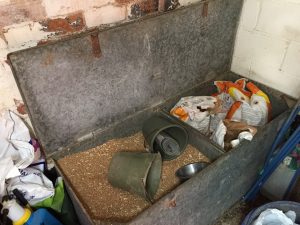
Types of Chicken Feed
Let’s run through what you are likely to see on the outside of the feed bag, and which one is right for your flock.
You’ll be choosing one of 6 types of chicken feed, and these are your options:
-
Chicken Mash
Chicken mash is unprocessed feed, it’s a fine as a powder. So, it can be fed wet or dry to chicks or adult laying hens and cockerels.
-
Chicken Pellets
Feed in a pelleted form.
-
Crumbles (Crumb)
Exactly as its stated chicken feed that crumbled, but not as fine as powder.
-
Medicated
Medicated chicken feed has an active ingredient called coccidiostat to help prevent and treat [illnesses related to parasites, in particular, Coccidian Protozoa].
-
Un–Medicated
Un-medicated chicken feed that doesn’t contain coccidiostat.
-
Fermented
This chicken feed has been mixed with water and allowed to ferment naturally. Said to help aid digestion within chickens and maintain gut health.
What Type of Chicken Feed Do I Need?
So, you’re planning on introducing chicks to your coop.
What do I feed my chicks? And do I feed my chickens the same thing?
| Type of Chicken Feed | Most Suitable For | Nutrient Content | Image |
|---|---|---|---|
| Chick crumb or Chick Mash | up to 6 weeks | 19% Calcium | 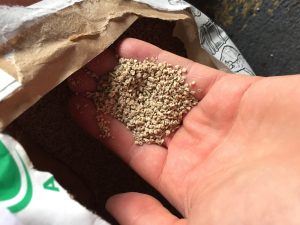 |
| Growers Mash or Growers Pellets | 6 - 18 weeks | 15-16% Calcium | 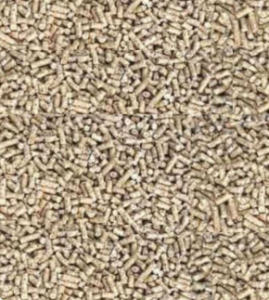 |
| Layers Pellets or Layers Mash | 18 weeks onwards | 15-17% Calcium | 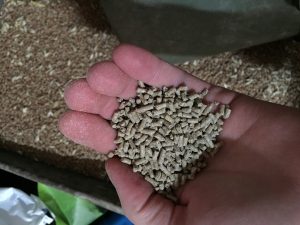 |
How Much You Should Feed Chickens
Chicks
From day 1 they have feed constantly in their feeders and I will top up accordingly with as much as they eat. Basically, whatever they eat – I replace. Simple.
Adult Chickens
From say after a few weeks after they start laying and you are getting your gorgeous eggs, I measure out the feed on a daily basis and feed them just that amount.
How much? Feed amount will differ per breed but between 2.9oz (80grams) and 4.3oz (120grams) per day.
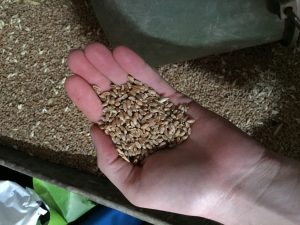
This works for me, the benefits are they have a feeding pattern and routine, it will attract less rodents as all the feed is eaten within a few minutes.
I can scatter some feed around outside the coop so the chickens can forage away to their hearts content. The big one for me though, and again this is just preference, is the chickens come running over to greet me when I have feed for them, I love this even if it is cupboard love!
I don’t, but I know people who do and say its so easy to buy and store a chicken feed in. There’s no smell, kept air tight and at room temp so you can keep it in the kitchen – maybe you’d want one?
My hens are all tame but if they weren’t, getting up closer to them as they await their feed allows you to check them over to see all is well and that they are healthy.
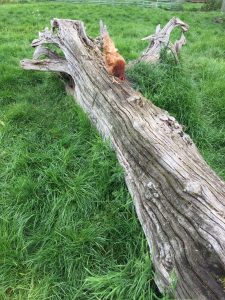
That’s one method, the other is having the chicken feeder full all the time. Its no bad thing, to know that they are constantly going to have enough food, it certainly is one less thing to worry about. There are benefits for both methods, find one that works for you don’t look back. Happy chickens means a happy life!
How often do you feed chickens?
If your chickens are not going to have constant supply of food in the feeder then the question – How many times a day should I feed my chickens? – needs to be answered. I get asked this a lot.
Chickens generally eat quite a lot in the morning so breakfast, after you have let them out the coop, is an important time.
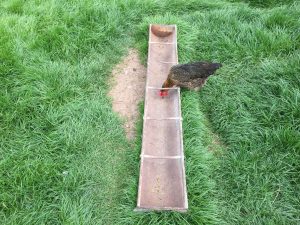
A feeder trough like mine, as shown in the photo is the very best. Its metal so its hard wearing (ours is over 25 years old) its means all the chicken can eat at the same time they are more expensive but worth the money in my eyes check out the reviews online for yourself. The metals bars are great, an upgrade infact, as they cant stand in the feeder and poop.
They will then forage and graze throughout the day plus spending time of course in the nesting boxes producing your wonderful eggs, then in the evening a couple hours before your shut them in the coop for the night I give them their ‘supper’.
Chicken Grit
Why Do Chickens Need Chicken Grit?
If you’re thinking, do my chickens even need chicken grit? The answer is yes.
Chickens don’t have teeth, so they use an organ inside them called the gizzard to, in essence, ‘do their chewing’. The grit sits inside the gizzard for a short while to crush up the chicken feed so it can be easily digested.
A common question we’re asked is do I need to give my chickens grit if they are free range? – Yes and No. Free range hens generally will find and use small stones. If hens don’t have access to that in your backyard supplementary grit can be provided with or alongside their feed.
Types of Chicken Grit
We know it’s important, so what is chicken grit? Grit, as it is referred to are, stones (flint) or shells. [You can buy them from any feed store, but feeding chickens eggshells is an option. Make sure its dried out and crushed up].
| Age | Supplement Type |
|---|---|
| 0 - 8 weeks | Chick Grit |
| 8 - 20 weeks | Grower Grit |
| 20+ weeks | Layers Grit, Oyster Shell |
Breeders Top Tip: What you don’t want is chicks to mistake grit for feed. When giving baby chicks grit, start by sprinkling it over the main feed. Do this for the first week or two, this helped my chicks establish the correct feeding habits. After that provide it in a separate container, similar to the one show in the picture below, for the poultry to consume as and when they require it.
How To Feed Chickens
Using a feeder, place the desired amount of feed into it, making sure the lid is firmly replaced and that is it sat on flat stable ground so it can’t be knocked over, and out of direct sunlight.
Feeding chickens off the floor is also fine, but there are a few downsides including:
- Difficult if there is snow on the ground
- Feed gets trodden in, costing you money
- If left, it will attract rodents, or go moldy and attract other nasties.
Mine eat feed straight out my hand!
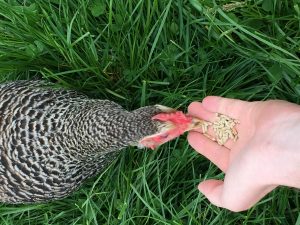
What Not To Feed Chickens
What not to feed chickens, is just as important as what to feed them. I’ve covered in detail in another section on the website, but the basics are here again.
Here are the 3 things you absolutely shouldn’t feed chickens:
-
Anything Moldy
It sounds obvious but if its not fit for human consumption, its probably not fit for poultry.
-
Dried or Raw Beans
The phytohemagglutinin in beans is a killer for chickens. Kidney beans then are a massive no-no.
On that note, remember to check that you don’t have any bean plants growing in the vicinity of your chickens too, as they could eat them by accident.
-
Chocolate
It’s as harmful in chickens as it is in cats and dogs. Chocolate can be fatal if eaten by chickens. It causes heart problems which can results in full cardiac arrest within 24 hours.
The reason? Chocolate contains theobromine and caffeine. In fact, the darker the chocolate the more theobromine it contains and there more dangerous it is to chickens.
Do your chickens a favor and eat the chocolate yourself!
Shopping List
So, now you know how, what and when to feed your chickens.
If you’re not setup for backyard chickens yet, here’s a quick shopping list:
That’s all the things I use to keep my chickens fed and watered.
That’s a wrap!
Want to learn more about raising your girls? Jump over to our page covering how to raise chickens.
Got questions? Drop us a line via our contact form, and we’ll do our best to lend a hand.
